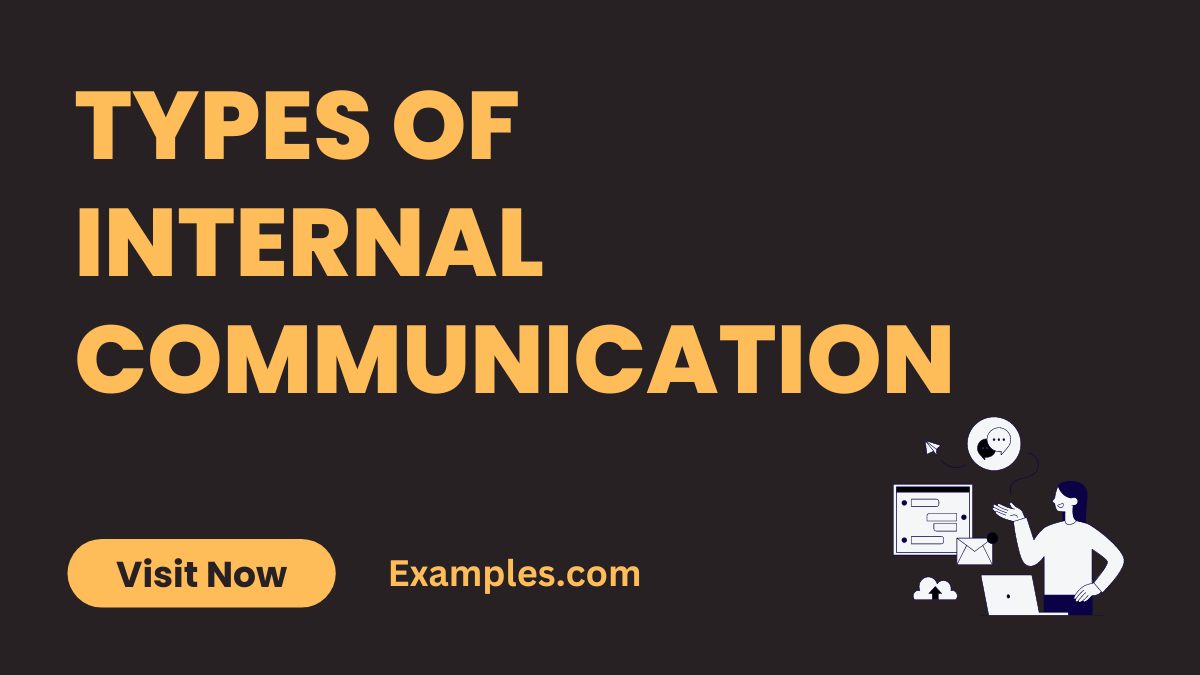Types of Internal Communication – Examples, Types
In today’s dynamic corporate landscape, effective Internal Communication is pivotal for organizational success. This complete guide delves into various types of internal communication, providing practical Internal Communication Examples to illustrate each type. From formal meetings to informal team chats, understanding these diverse forms is crucial for fostering a collaborative and productive workplace environment. Explore how each communication style contributes to overall business efficiency and employee engagement, and learn how to implement these strategies effectively.
What Are The Types of Internal Communication? – Definition
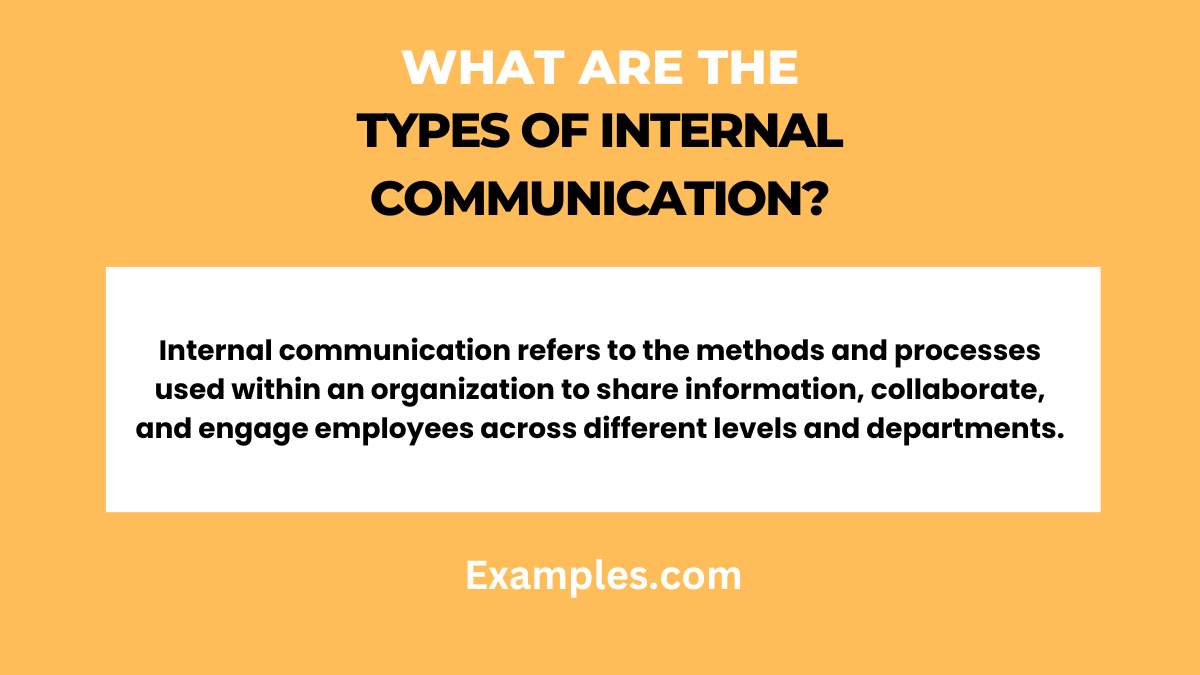
Internal Communication refers to the methods and processes used within an organization to share information, ideas, and feedback among its members. This essential aspect of business operations includes a variety of forms, such as formal announcements, team meetings, and informal chats. Effective internal communication is key to ensuring everyone is aligned with the company’s goals and objectives. It encompasses everything from day-to-day conversations to strategic Internal Communication Plans, playing a vital role in enhancing Employee Engagement and organizational efficiency.
20 Types of Internal Communication
In the intricate world of organizational dynamics, understanding the various types of internal communication is crucial. This guide delves into the 20 essential types that facilitate effective information flow within a company. From formal emails to informal social media groups, each form plays a pivotal role in enhancing collaboration, productivity, and employee engagement. We’ll explore how these communication types contribute to a cohesive work environment, fostering a culture of openness and informed decision-making in the business landscape.
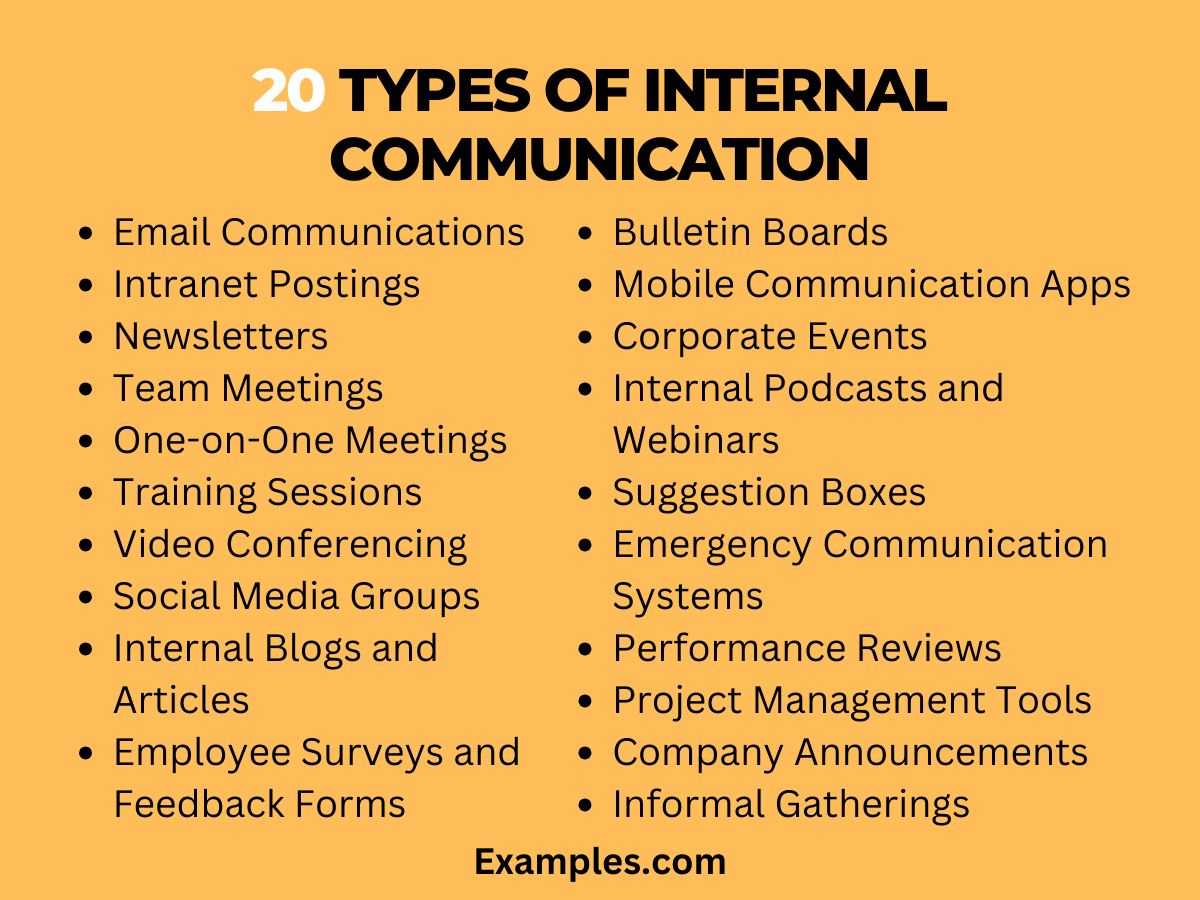
1. Email Communications
Emails are essential in any organization, used for a range of purposes from daily updates to formal announcements. They are a key part of the Internal Communication Strategy, providing a reliable and documented method of sharing Internal Communication Examples and important information.
2. Intranet Postings
An intranet is a vital Internal Communication Platform, acting as a central hub for company news, policies, and resources. It’s crucial for the Internal Communication in Business, allowing for efficient information dissemination across different departments.
3. Newsletters
Internal newsletters, distributed either digitally or in print, keep employees up-to-date with the latest Internal Communication Activities and news. They play an important role in the Benefits & Uses of Internal Communication by fostering a sense of community.
4. Team Meetings
Team meetings are fundamental for discussing projects and sharing updates, essential for Internal Communication in the Workplace. These meetings enable collaborative discussions and are a cornerstone of Internal Communication Best Practises.
5. One-on-One Meetings
One-on-one meetings between supervisors and employees are crucial for personalized feedback and mentoring, a key aspect of Internal Communication for Employee Engagement. These meetings are instrumental in How to Improve Internal Communication within teams.
6. Training Sessions
Training sessions are essential for skill development, aligning with the Importance of Internal Communication. They ensure employees stay updated with industry trends and organizational changes, thereby enhancing Internal Communication Functions.
7. Video Conferencing
Video conferencing is crucial in today’s global business environment, facilitating real-time communication across different locations. It is an integral part of modern Internal Communication Techniques, especially important for Internal Communication in Organizations with remote teams.
8. Social Media Groups
Internal social media platforms or groups offer a space for informal interactions among employees. They are emerging as a popular Internal Communication Tool, enhancing Internal vs External Communication dynamics.
9. Internal Blogs and Articles
Blogs and articles on internal platforms allow employees to share knowledge and experiences. This form of Internal Storytelling is an important aspect of Internal Communication Perspectives, promoting a culture of knowledge sharing.
10. Employee Surveys and Feedback Forms
Surveys and feedback forms are essential tools in Internal Communication in Company settings. They gather employee opinions and are a key part of Internal Communication Activities, aiding in decision-making processes.
11. Bulletin Boards
Bulletin boards, used for displaying important notices, are a traditional yet effective Internal Communication Channel. They are particularly useful in Internal Communication in Healthcare and other sectors where timely information dissemination is critical.
12. Mobile Communication Apps
Mobile apps offer instant messaging and alerts, essential for modern Internal Communication Strategies. These apps are becoming increasingly popular in Internal Communication in Business, facilitating real-time connectivity.
13. Corporate Events
Corporate events, like town halls and seminars, are key for Internal Communication in Organization. They offer platforms for networking and information sharing, crucial for Internal vs Marketing Communication.
14. Internal Podcasts and Webinars
Podcasts and webinars are innovative Internal Communication Platforms, used for sharing knowledge and updates. They cater to the evolving landscape of Internal Communication in Public Relations and similar fields.
15. Suggestion Boxes
Suggestion boxes encourage employees to contribute ideas, a vital part of Internal Communication Techniques. They foster innovation and are an essential component of Internal Communication Best Practises.
16. Emergency Communication Systems
Emergency communication systems are crucial for safety and quick response during crises. They are a key aspect of Internal Communication in Hospitals and other organizations where immediate communication is essential.
17. Performance Reviews
Performance reviews are a formal part of Internal Communication Jobs/Careers, providing feedback for personal and professional development. They align with Internal vs Interpersonal Communication principles, focusing on individual performance.
18. Project Management Tools
Project management tools are essential for collaboration on specific projects, enhancing Internal Communication in the Workplace. They improve transparency and accountability, key elements of Internal Communication Strategies.
19. Company Announcements
Company announcements are formal communications essential for Internal Communication in Organizations. They inform employees about significant changes or achievements, aligning with Internal Communication Plan Examples.
20. Informal Gatherings
Informal gatherings, like team lunches and social events, are crucial for Internal Communication between Employees. They promote a positive culture and are an integral part of Internal Communication for Employee Engagement.
Each type plays a unique role in the Internal Communication Strategy of an organization, emphasizing the Importance of Internal Communication. By utilizing these diverse forms, businesses can ensure a well-informed, engaged, and collaborative workforce.
Types of Internal Communication in Business
Effective internal communication in business is pivotal for operational success and employee engagement. It comprises various approaches and tools used to facilitate information sharing and coordination. Understanding the Types of Internal Communication and their application in the business environment can significantly enhance organizational efficiency and employee morale.
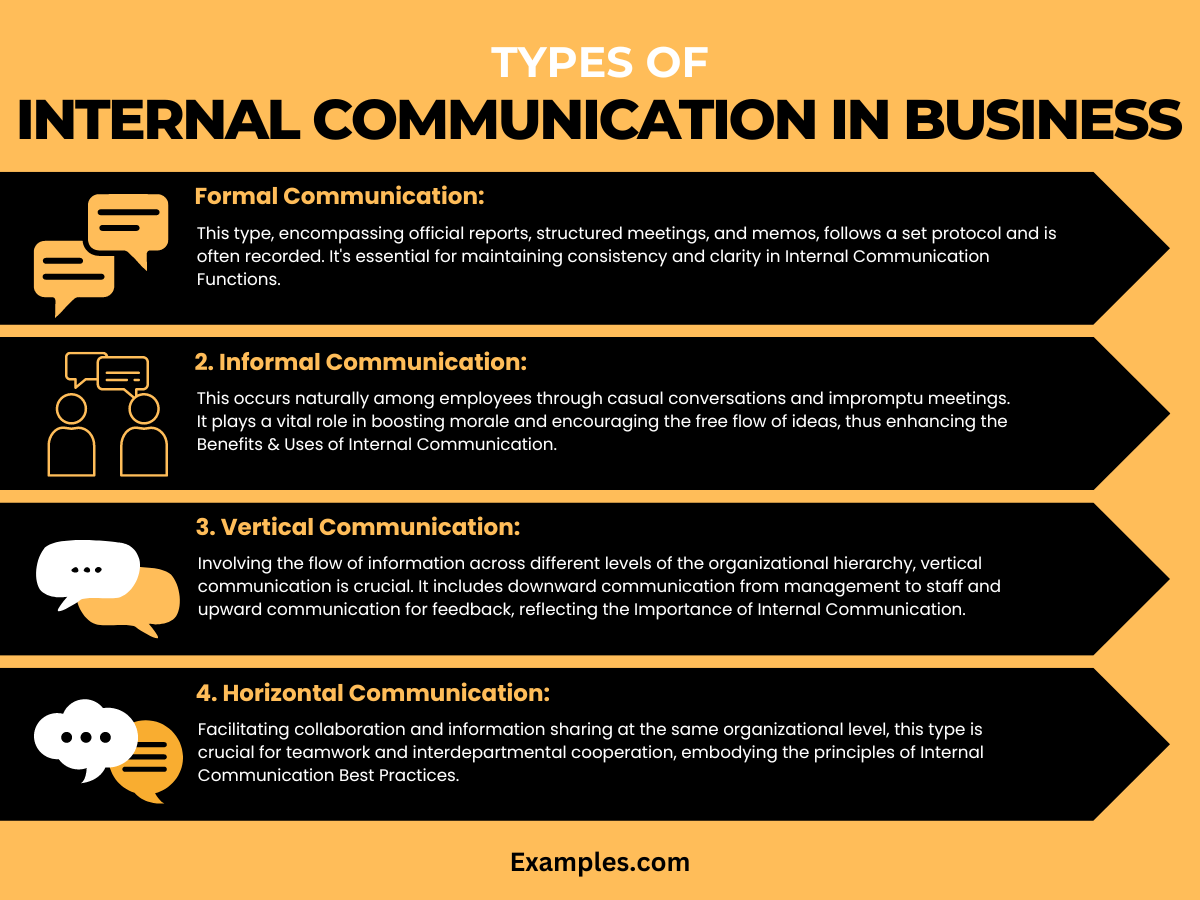
- Formal Communication: This type, encompassing official reports, structured meetings, and memos, follows a set protocol and is often recorded. It’s essential for maintaining consistency and clarity in Internal Communication Functions.
- Informal Communication: This occurs naturally among employees through casual conversations and impromptu meetings. It plays a vital role in boosting morale and encouraging the free flow of ideas, thus enhancing the Benefits & Uses of Internal Communication.
- Vertical Communication: Involving the flow of information across different levels of the organizational hierarchy, vertical communication is crucial. It includes downward communication from management to staff and upward communication for feedback, reflecting the Importance of Internal Communication.
- Horizontal Communication: Facilitating collaboration and information sharing at the same organizational level, this type is crucial for teamwork and interdepartmental cooperation, embodying the principles of Internal Communication Best Practices.
- Diagonal Communication: This type of communication, which crosses traditional lines, occurs between various levels and departments, fostering a more dynamic and integrated approach to Internal Communication in Organization.
By leveraging these varied types of internal communication, businesses can significantly improve their internal dynamics, leading to better Internal Communication in the Workplace and overall organizational health.
Types of Internal Communication Strategies
Developing effective Internal Communication Strategies involves a mix of understanding organizational goals, employee needs, and selecting the right communication channels. A strategic approach to internal communication is critical for aligning employees with the organization’s objectives and fostering a positive workplace culture.
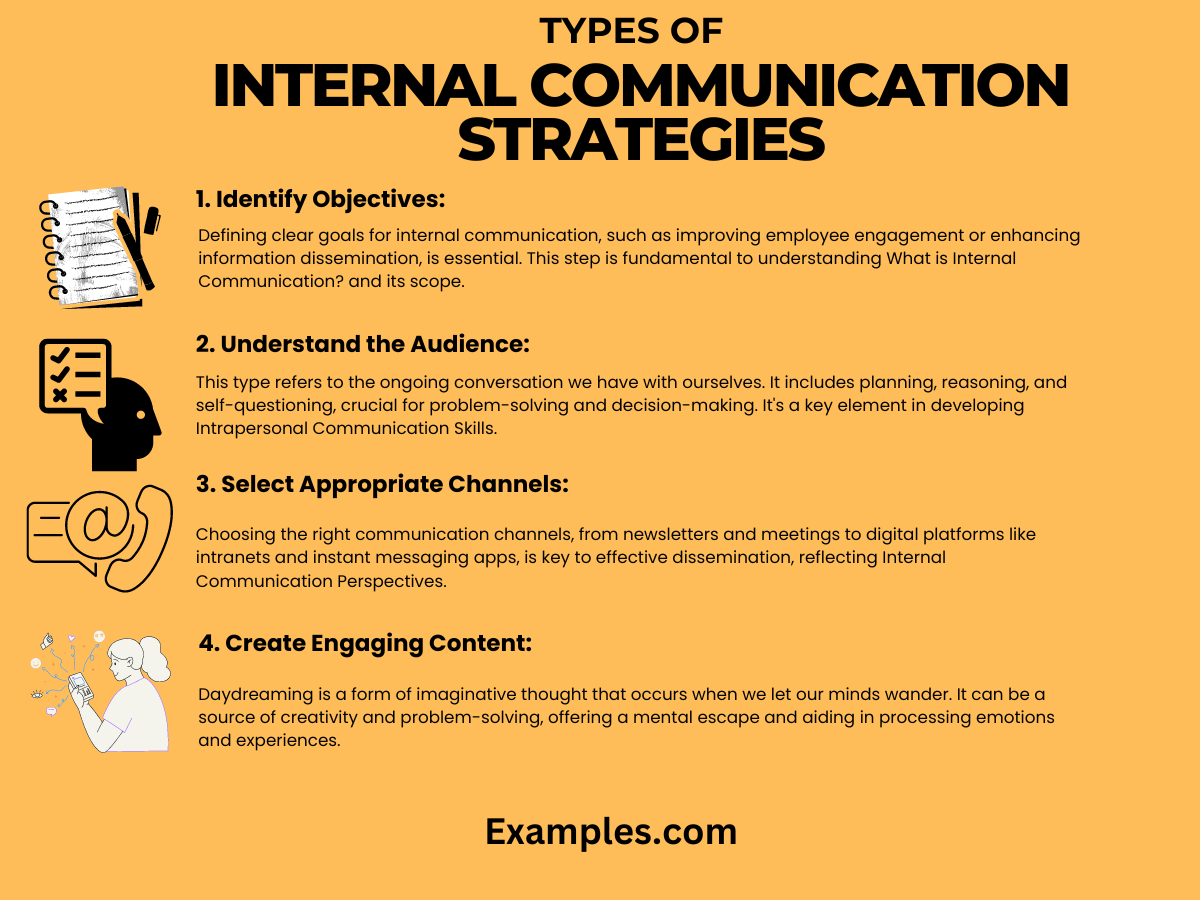
- Identify Objectives: Defining clear goals for internal communication, such as improving employee engagement or enhancing information dissemination, is essential. This step is fundamental to understanding What is Internal Communication? and its scope.
- Understand the Audience: Tailoring the communication strategy to meet employee needs and preferences is vital. This includes recognizing their challenges and preferences in accessing information, an aspect central to Internal Communication Techniques.
- Select Appropriate Channels: Choosing the right communication channels, from newsletters and meetings to digital platforms like intranets and instant messaging apps, is key to effective dissemination, reflecting Internal Communication Perspectives.
- Create Engaging Content: Developing relevant, clear, and engaging content ensures that the communication is effective. This aspect is crucial in How to Improve Internal Communication.
- Encourage Two-Way Communication: Fostering a culture of openness and trust by encouraging feedback and dialogue is essential. This approach is integral to How to Explain Internal Communications?.
- Measure and Adapt: Regular assessment through surveys and feedback is crucial for refining the strategy, an important aspect of Internal Communication Activities.
Incorporating these strategies can ensure that internal communication within a business is not only effective and efficient but also contributes significantly to achieving broader organizational goals.
In conclusion, understanding and implementing various types of internal communication is essential for any business aiming to foster a collaborative, efficient, and engaged workplace. By embracing diverse communication methods and developing strategic approaches, organizations can enhance information flow, employee satisfaction, and overall productivity. This guide offers valuable insights and tips to effectively navigate the complex landscape of internal communication.



